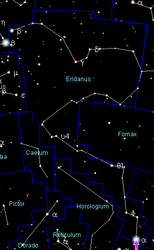Achernar (star)
| Achernar (star) | |
|---|---|
| Observational Data | |
| Designation | Alpha Eridani HD 10144 |
| Right ascension | 01h 37m 42.85s |
| Declination | 57o 14′ 12.3″ |
| Constellation | [[Eridanus]] |
| Type of object | [[Star]] |
| Magnitude | Absolute Mag: -2.27 Apparent Mag:0.50 |
| Astrometry | |
| Distance from Earth | 139 ±3 ly |
| Radial velocity | 16 km/s |
| Proper motion | RA: 87.00 ±0.58 mas/yr Dec.: −38.24 ±0.50 mas/yr |
| Parallax | 023.39 ±0.57 mas |
Achernar, also known as Alpha Eridani, is the brightest star of the constellation Eridanus, and the ninth brightest star overall in the night sky. The star is not well known to those in the northern hemisphere, as it is only visible to those who live south of 32 degrees north latitude. South of 33 degrees south latitude, the star is circumpolar.
The name Achernar, sometimes spelled as Achenar, is derived from the Arabic آخر النهر ākhir an-nahr, meaning "the End of the River". In Chinese though, the star is called 水委一 (Shuǐwěiyī), meaning "the First Star of the Crooked Running Water".[1]
Achernar is a blue main sequence star of spectral type B3 Vpe, located 144 light years away. The star's mass is between six and eight times that of our Sun,[2] and 14.4 to 24 times its diameter.[3] The star is 1,070 times as visually luminous as the Sun, but depending on the estimate of ultraviolet radiation the star emits, is 2,900 to 5,400 times as great as the Sun in total luminosity. Surface temperature estimates range from 14,500 to 19,300 K.
A fast-rotating star, Achernar has a spin velocity of 225 to 300 kilometers per second, completing a rotation of only 2.1 days, causing the star to eject mass at a rate thousands of times greater than our Sun. Because of this, Achernar is classified as a "Be" (B-emission) star, with an expanding circumstellar envelope of gas circulating around the equator. The tremendous speed also gives Achemar a distinct oblate spheroid shape. Its equatorial radius measures some 11.6 Suns across, while the polar radius measures only 7.5 Suns across, making the star more than 50 percent wider at the equator than at the poles.[2]
Achernar is still young enough, being only a couple hundred million years old, to still be fusing hydrogen into helium in its core. It will burn through its core fuel quickly however, and eventually evolve into a large white dwarf, much like Sirius B.[4]
There are no known substaller companions to Achernar. For an Earth-like to have liquid water on its surface, the hypothetical planet's orbit would be centered around 54 to 73 AUs, an orbit greater then the orbit of Pluto. At such a distance, the planet would take between 160 and 260 years to orbit Achernar.[5]
References
- ↑ Star-names and Their Meanings, Richard Hinckley Allen, New York: G. E. Stechert, 1899, p. 218
- ↑ 2.0 2.1 http://adsbit.harvard.edu/cgi-bin/nph-iarticle_query?bibcode=1988BAICz..39..329H
- ↑ http://adsabs.harvard.edu/cgi-bin/nph-bib_query?bibcode=2003A%26A...407L..47D
- ↑ http://stars.astro.illinois.edu/sow/achernar.html
- ↑ http://www.solstation.com/x-objects/achernar.htm
